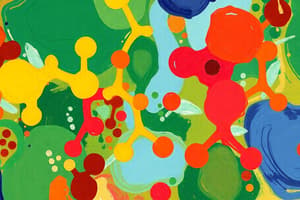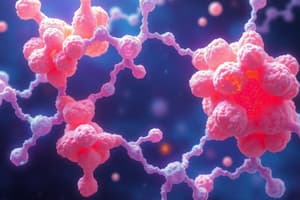Podcast
Questions and Answers
What is the primary function of carbohydrates in the human body?
What is the primary function of carbohydrates in the human body?
- Building and repairing tissues
- Providing a concentrated source of energy (correct)
- Regulating hormones
- Acting as catalysts for biochemical reactions
Which of the following is a characteristic property of monosaccharides?
Which of the following is a characteristic property of monosaccharides?
- They are the simplest form of carbohydrates and cannot be hydrolyzed further. (correct)
- They are insoluble in water.
- They form long, branched chains.
- They are composed of multiple sugar units linked together.
The hydrolysis of a disaccharide results in which of the following?
The hydrolysis of a disaccharide results in which of the following?
- An amino acid and a fatty acid
- Two monosaccharides (correct)
- A monosaccharide and a polysaccharide
- A polysaccharide
Which qualitative test is commonly used to detect the presence of starch?
Which qualitative test is commonly used to detect the presence of starch?
Glycogen is a polysaccharide that functions as a storage form of glucose in which organisms?
Glycogen is a polysaccharide that functions as a storage form of glucose in which organisms?
What type of bond is formed when two monosaccharides are joined together to form a disaccharide?
What type of bond is formed when two monosaccharides are joined together to form a disaccharide?
Which of the following carbohydrates is a structural component of plant cell walls?
Which of the following carbohydrates is a structural component of plant cell walls?
In Benedict's test, what color change indicates the presence of reducing sugars in high concentration?
In Benedict's test, what color change indicates the presence of reducing sugars in high concentration?
Which of the following is an example of an oligosaccharide?
Which of the following is an example of an oligosaccharide?
What is the main difference between amylose and amylopectin?
What is the main difference between amylose and amylopectin?
Which of the following reactions is commonly used to break down polysaccharides into monosaccharides?
Which of the following reactions is commonly used to break down polysaccharides into monosaccharides?
What role do carbohydrates play in cell-to-cell recognition and adhesion?
What role do carbohydrates play in cell-to-cell recognition and adhesion?
Which test is used to differentiate between aldose and ketose sugars?
Which test is used to differentiate between aldose and ketose sugars?
What is the significance of dietary fiber, which is a type of carbohydrate, in human nutrition?
What is the significance of dietary fiber, which is a type of carbohydrate, in human nutrition?
How does the branching structure of glycogen contribute to its function?
How does the branching structure of glycogen contribute to its function?
What are advanced glycation end products (AGEs), and how are they formed?
What are advanced glycation end products (AGEs), and how are they formed?
Which of the following is a characteristic of chitin?
Which of the following is a characteristic of chitin?
What is the role of amylase in carbohydrate digestion?
What is the role of amylase in carbohydrate digestion?
Which of the following describes the primary function of glycoproteins and glycolipids in the cell membrane?
Which of the following describes the primary function of glycoproteins and glycolipids in the cell membrane?
How does high-fructose corn syrup (HFCS) differ from sucrose in its composition?
How does high-fructose corn syrup (HFCS) differ from sucrose in its composition?
Flashcards
What are Carbohydrates?
What are Carbohydrates?
Organic compounds made of carbon, hydrogen, and oxygen, often with a ratio of 1:2:1, and are the primary source of energy for living organisms.
Name the basic types of Carbohydrates
Name the basic types of Carbohydrates
Monosaccharides (e.g., glucose, fructose), disaccharides (e.g., sucrose, lactose), and polysaccharides (e.g., starch, cellulose).
What are Reducing Sugars?
What are Reducing Sugars?
Reducing sugars have a free aldehyde or ketone group that can reduce other substances. Examples include glucose, fructose, and lactose.
What is Benedict's Test?
What is Benedict's Test?
Signup and view all the flashcards
What does the Iodine test indicate?
What does the Iodine test indicate?
Signup and view all the flashcards
Study Notes
-
What are carbohydrates, and what are their primary functions in living organisms? Provide three examples of common carbohydrates and their respective roles.
- Carbohydrates are organic compounds composed of carbon, hydrogen, and oxygen, typically with a hydrogen-to-oxygen ratio of 2:1 (as in water); their primary functions include providing energy, serving as structural components, and participating in cell recognition
- Examples: glucose (energy source), starch (energy storage in plants), and cellulose (structural component in plant cell walls)
- Carbohydrates are organic compounds composed of carbon, hydrogen, and oxygen, typically with a hydrogen-to-oxygen ratio of 2:1 (as in water); their primary functions include providing energy, serving as structural components, and participating in cell recognition
-
Describe the three main types of carbohydrates: monosaccharides, disaccharides, and polysaccharides. Give an example of each, and explain how they differ in terms of structure and complexity.
- Monosaccharides are simple sugars with the general formula (CH2O)n
- Example: glucose
- Disaccharides consist of two monosaccharides joined by a glycosidic bond
- Example: sucrose (glucose + fructose)
- Polysaccharides are complex carbohydrates composed of many monosaccharide units linked together in long chains
- Example: starch (polymer of glucose)
- Monosaccharides are the simplest, disaccharides are two monosaccharides joined, and polysaccharides are long chains of monosaccharides, increasing in complexity and size
- Monosaccharides are simple sugars with the general formula (CH2O)n
-
Explain the difference between reducing and non-reducing sugars. Provide an example of each, and describe a simple chemical test that can be used to distinguish between them.
- Reducing sugars have a free aldehyde or ketone group that can reduce other compounds, while non-reducing sugars do not
- Example: glucose is a reducing sugar
- Example: sucrose is a non-reducing sugar
- Benedict's test can distinguish them
- Reducing sugars reduce the copper(II) ions in Benedict's reagent to copper(I) oxide, forming a colored precipitate, while non-reducing sugars do not react
- Reducing sugars have a free aldehyde or ketone group that can reduce other compounds, while non-reducing sugars do not
-
Describe the process of photosynthesis and its importance in carbohydrate synthesis. What are the main reactants and products of this process, and how do they contribute to the overall carbon cycle?
- Photosynthesis is the process by which plants and other organisms convert light energy into chemical energy in the form of glucose or other carbohydrates
- Reactants: carbon dioxide and water
- Products: glucose and oxygen
- The overall reaction is 6CO2 + 6H2O + light energy → C6H12O6 + 6O2
- This process removes carbon dioxide from the atmosphere and produces oxygen, contributing to the carbon cycle by incorporating atmospheric carbon into organic molecules
- Photosynthesis is the process by which plants and other organisms convert light energy into chemical energy in the form of glucose or other carbohydrates
-
Explain the role of carbohydrates in energy storage in both plants and animals. What are the primary storage forms of carbohydrates in each case, and how are they synthesized and broken down to meet energy demands?
- In plants, carbohydrates are primarily stored as starch, a polymer of glucose
- Synthesized through photosynthesis and stored in structures like amyloplasts
- Broken down via hydrolysis during cellular respiration to release glucose for energy
- In animals, carbohydrates are stored as glycogen, primarily in the liver and muscles
- Synthesized from glucose and stored in granules
- Broken down via glycogenolysis to release glucose when energy is needed
- In plants, carbohydrates are primarily stored as starch, a polymer of glucose
Studying That Suits You
Use AI to generate personalized quizzes and flashcards to suit your learning preferences.




